To complete our ongoing series on exotic hulls, it is now time to turn our attention to a type of vessel that not only straddles the boundary between the ship and the airplane, but arguably crosses it to be even more airplane than ship. Variously known as the Ground Effect Vehicle, Wing-in-Ground Effect or Ekranoplan,1 these look mostly like aircraft, but take advantage of a quirk of aerodynamics known as "ground effect" to greatly reduce drag, so long as they are operating near the surface.
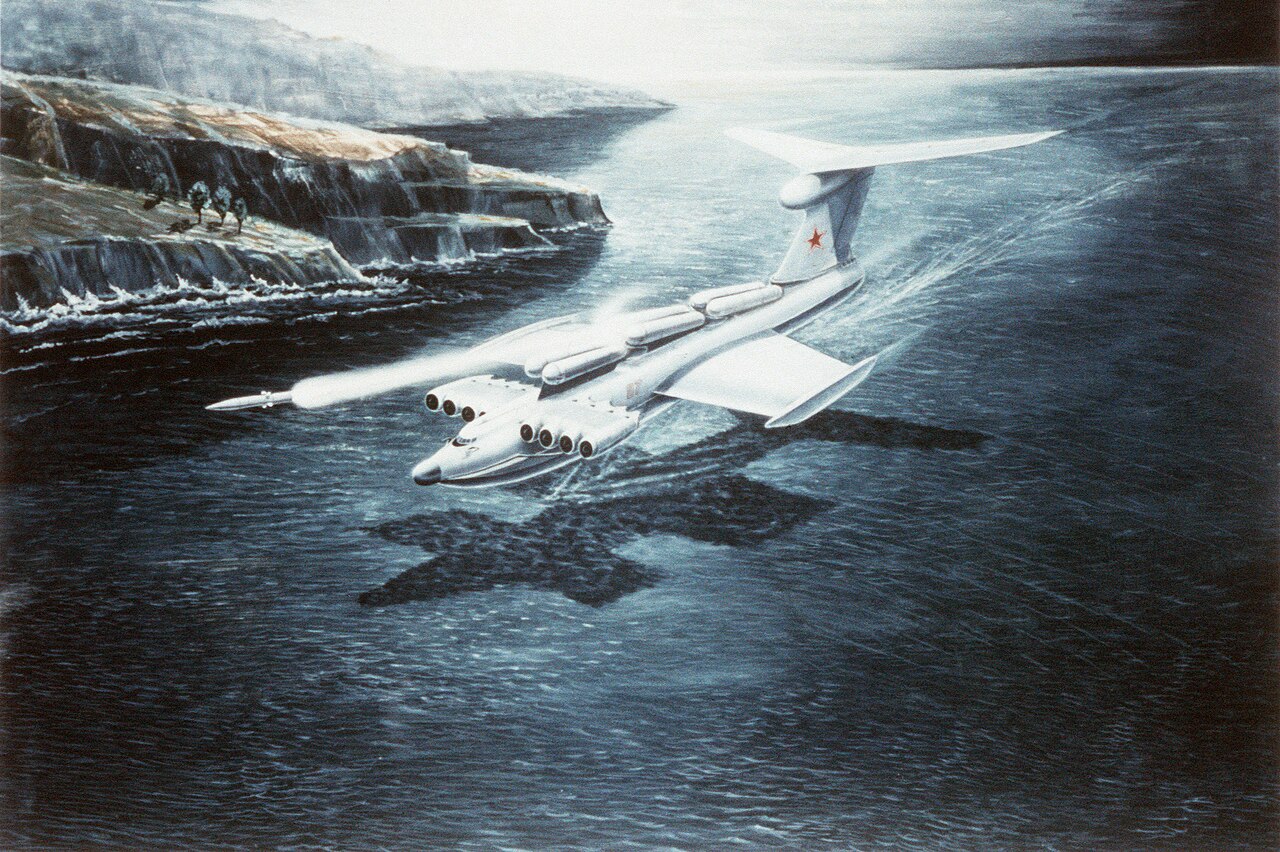
It's probably worth starting by explaining what ground effect is and how it works. Basically, in the process of producing lift, an airplane's wing also produces a vortex that makes drag.2 But if the wing is close to the ground (or water), then the surface will disrupt the vortex, slashing drag dramatically, in a manner determined by the ratio of wingspan to height above the ground. For instance, a wing that is 10% of the wingspan above the ground will only experience about 20% of the induced drag it would at altitude, rising to around 50% at 20% wingspan. This makes taking off in an airplane easier, and landing a bit harder, and in theory could be used to significantly improve the performance of an airplane.
The biggest problem, of course, is how low you have to fly. Take the last plane you flew on, which statistically was either a Boeing 737 or an Airbus A320.3 These are both fairly large planes, and each has a wingspan of about 120', which implies that to take full advantage of ground effect, they'd need their wings to be about 12' off the ground. Coincidentally, this is just about how far off the ground the wingtips of both airplanes are when they're sitting on the ground. Obviously, a purpose-built ekranoplan would be designed with engines above the wing, but even then, a vehicle which is designed to operate at high speed and is thwarted by a single-story building isn't really practical for operations over land, unless you happen to have somewhere very flat and devoid of all natural and man-made obstacles, like an ice field or Florida after a really big hurricane.
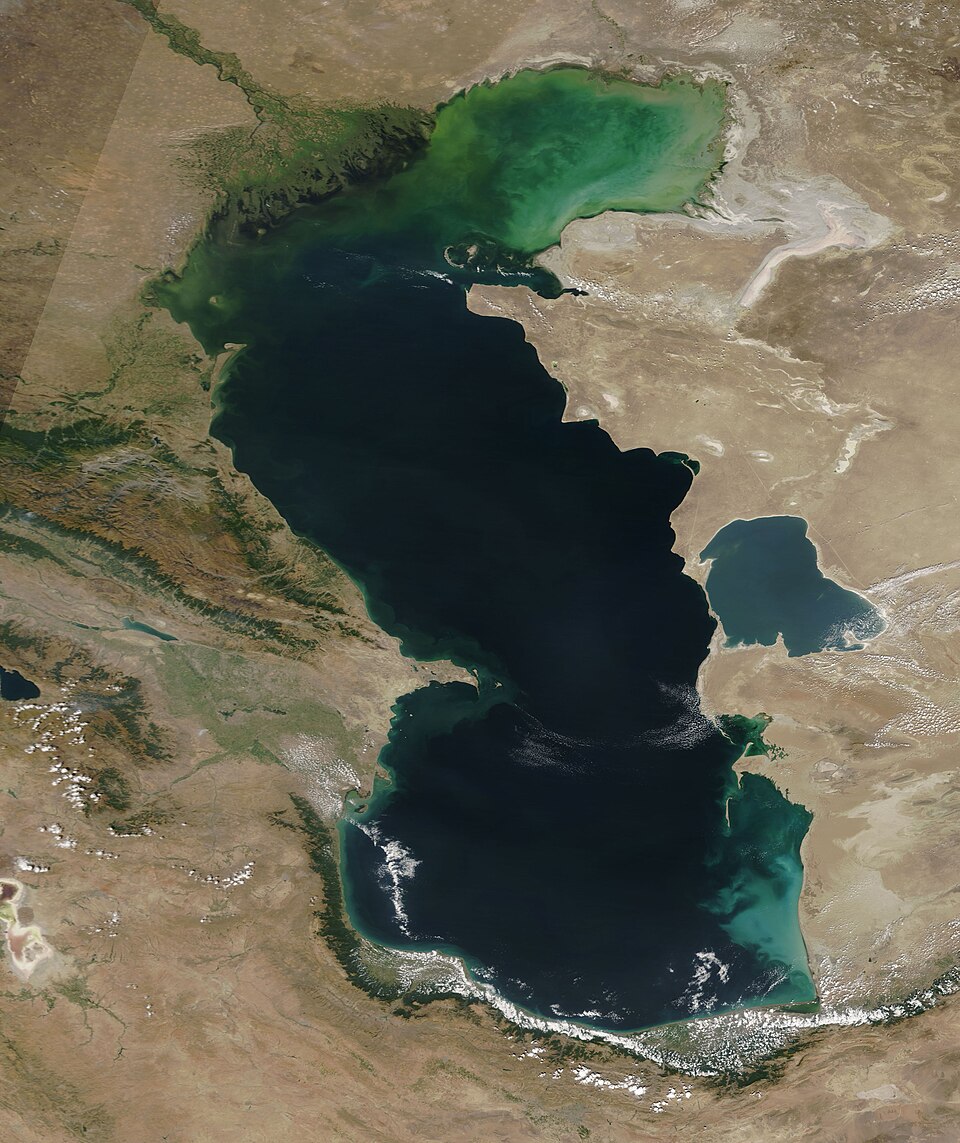
The Caspian Sea
As a result of all this, in practice the ekranoplan is limited to operations over water, and almost all are designed to use that same water as a runway, most being fairly typical flying boat hulls which use planing to get up to flying speed. But even water is not always smooth, which can pose a serious problem for the operation of an ekranoplan in many areas. In the North Atlantic4 average wave height will exceeding cruising height for even a big ekranoplan at least 20% of the time, to say nothing of cases where the biggest outlier wave might be enough to bring one down. Even if all of that is dealt with, flying an ekranoplan over moderate waves will result in frequent changes in aerodynamic properties, making for an exceedingly rough ride. To date, pretty much all Ekranoplan testing has been done in the Caspian Sea, the world's largest lake5 and a place where the typical wave height doesn't get much above 1.2 m.

Ekranoplan designer Rotislav Alexeyev
Legally and practically, ekranoplans are divided into three types. First, vehicles that are completely incapable of operating out of ground effect. These are steered like ships, with nautical qualifications being all that is required of the helmsman, as there isn't even an elevator to use. Second, vehicles capable of operating outside of pure ground effect, if only for short periods, with the maximum altitude being the 500' that is generally considered minimum safe altitude for airplanes. Third, some ekranoplans are capable of true flight at higher altitude, being distinguished from flying boats primarily in being designed to operate while in ground effect as well as at altitude.
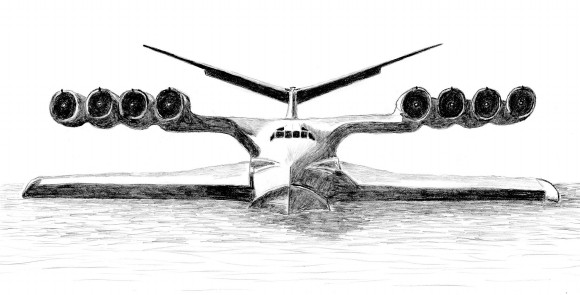
A sketch of the Caspian Sea Monster
The development of the ekranoplan as more than a theoretical curiosity is largely due to the efforts of one man, Rotislav Alexeyev, the leader of the Soviet Central Hydrofoil Design Bureau. Alexeyev had the expertise in both naval architecture and aeronautics to manage the ekranoplan project, and even served as a pilot during the test program, as well as the political acumen to get backing for it from both Nikita Khrushchev and Defense minister Dmitry Ustinov. After a number of test vehicles in the early 60s, authorization was given in 1963 for a large-scale prototype, known as KM, although it is better known by the moniker given to it by Western intelligence services, the Caspian Sea Monster. This was a result of the massive size of the vehicle, 92 m long and weighing 544 tons, the largest and heaviest airplane built to that point.6 In cruising flight, at a height of between 4 and 14 m, it was propelled by a pair of engines mounted in the tail, but takeoff required eight extra engines mounted in a row above the nose, with their exhausts directed downward to form an air cushion under the wing, easing the task of getting off the water. It's not clear what purpose an operational version of the KM would have served, and the prototype was destroyed by a crash in 1980.
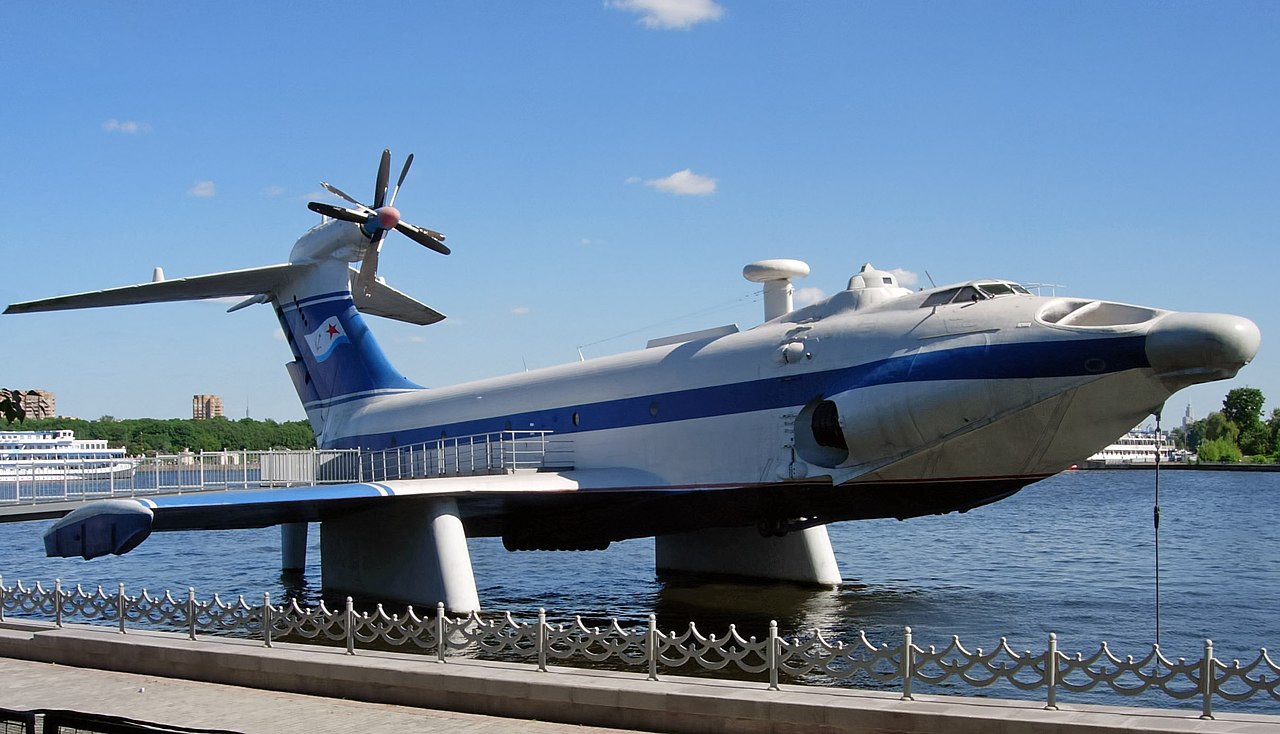
An Orlyonok in the Russian Navy Museum
A few years later, an operational ekranoplan was ordered, the Orlyonok. This was intended as a high-speed transport for the Soviet Navy, capable of carrying Soviet Naval Infantry and unloading them over a beach with their vehicles, the entire nose swinging 92° to load and unload things up to the size of a BTR. The cruise engine was a single turboprop in the tail, while two turbofans in the nose were used to get it airborne, with their exhaust being directed under the wing to help form an air cushion for takeoff, a process aided by the massive flaps, which helped seal the area under the wings and trap the engine exhaust more efficiently. Takeoff was also aided by the deployment of retractable hydroskis, which also had wheels to allow the Orkyonok to be moved around ashore. Three of this type were completed, and while they appeared to be reasonably successful, the cruising altitude of 2 m (6') would have been rather scary. A few flights were made out of ground effect, reaching past 100 m, but the aircraft was unstable and required an exceptional pilot to control at such altitudes. In theory, it could carry 30 tons of cargo 1000 km or more, but in practice, they were unable to find a good home in the bureaucratic mess of the Soviet armed forces, because nobody was sure if they were ships or airplanes. Ultimately, after a major crash in 1992, the surviving ekranoplans were retired, and plans for derivatives intended for tasks ranging from civilian ferry duty to ASW to prospecting in arctic waters were cancelled. A particularly insane plan was to combine the Orlyonok with the An-225 for search and rescue, with the massive Antonov carrying the ekranoplan to the scene of a disaster, then releasing it in the air to descend and provide aid to up to 70 survivors.
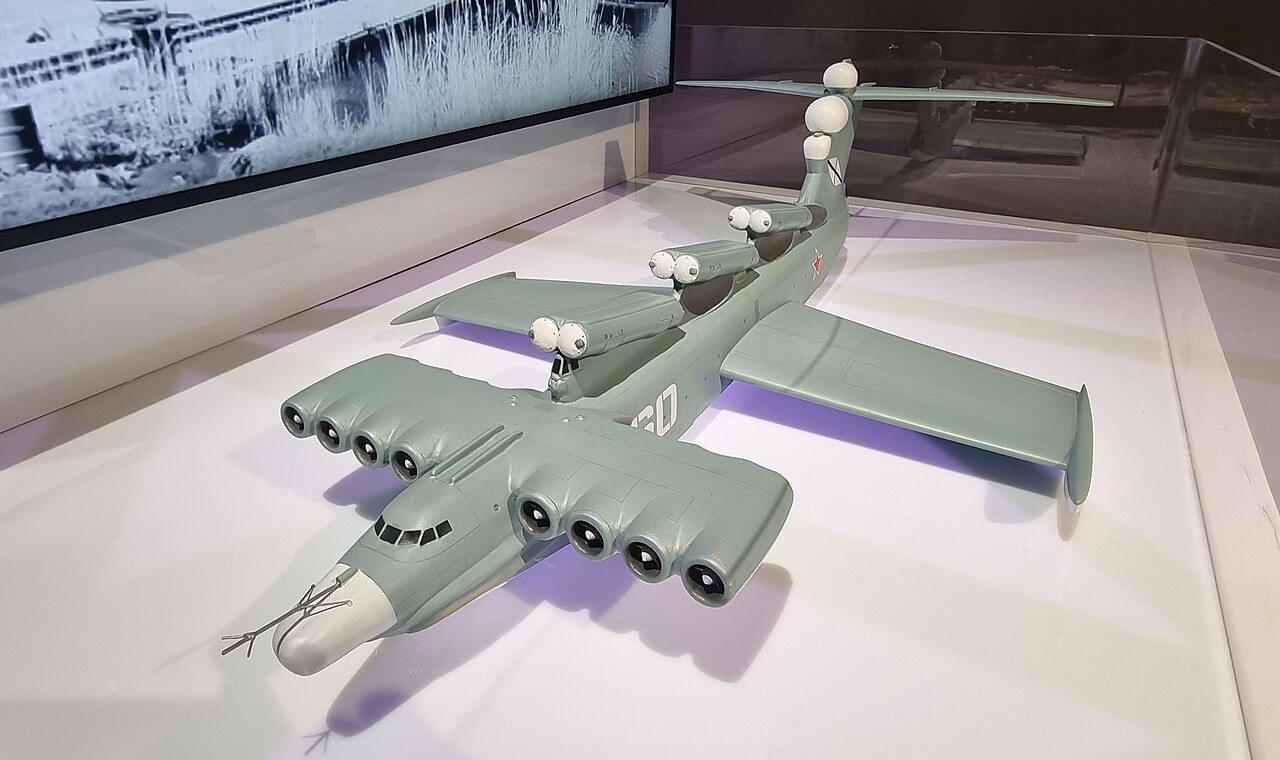
A model of the Lun class
But Orlyonok wasn't the only attempt by the Soviets to make an operational ekranoplan. A second, larger type of the same broad configuration was ordered, the Loon,7 designed as a missile platform. It carried six P-270 Moskit ramjet-powered anti-ship missiles, mounted in pairs on the back of the ekranoplan. Concerns about ingesting rocket exhaust during a missile launch meant that all eight engines (two cruise, six boost) were clustered behind the cockpit, while the top of the fin was occupied by radar and ESM gear. In practice, this wasn't particularly useful because the Loon's low altitude limited the radar horizon and made it dependent on other platforms for targeting information. But operating at low altitude also made it harder to see, potentially allowing it to play the role of a very fast missile corvette. The fall of the Soviet Union meant that the Russian government didn't really see things that way, and the one completed Loon was laid up, while a second unit, 80% complete, was suspended and for several years there were discussions of converting it into a SAR platform before this idea was scrapped.

The remains of VVA-14
Only one major ekranoplan was actually built to a design that didn't come from the Central Hydrofoil Design Bureau. Robert Bartini, an immigrant from Austria-Hungary, had been one of the Soviet Union's more innovative aircraft designers, and he became interested in the ekranoplan concept, although his version was definitely intended to be able to operate out of ground effect as well as in it. His chance to put at least some of his theories into practice came in the 1960s, when the Soviet government commissioned a VTOL ASW ekranoplan as part of their strategy to counter the American Polaris program. Details of the plan are hazy, but as best I can tell, the plan was to use the ekranoplan as something more like a very fast and reasonably stealthy surface ship,8 landing on the water and deploying a dunking sonar as its main sensor.9 The design Bartini came up with, known as VVA-14, had a very long central wing/fuselage section with a more conventional-looking wing outboard, and used two engines for cruise and 12 more to give it vertical takeoff ability, taking advantage of the ability of the center wing section to trap the exhaust of the takeoff engines and form an air cushion. This would give it the ability to operate from either land or water, in the latter case using inflatable floats. Astonishingly, nobody seems to have pointed out that everything involved with this was insane, and a prototype was actually built, first flying in 1972. But the lift engines were never delivered, so attempts were made to rework the VVA-14 into a more conventional ekranoplan with an extra pair of takeoff engines, and while this was successful in creating a flying craft, nobody was able to figure out what to do with it, so it was left to rot in a museum.
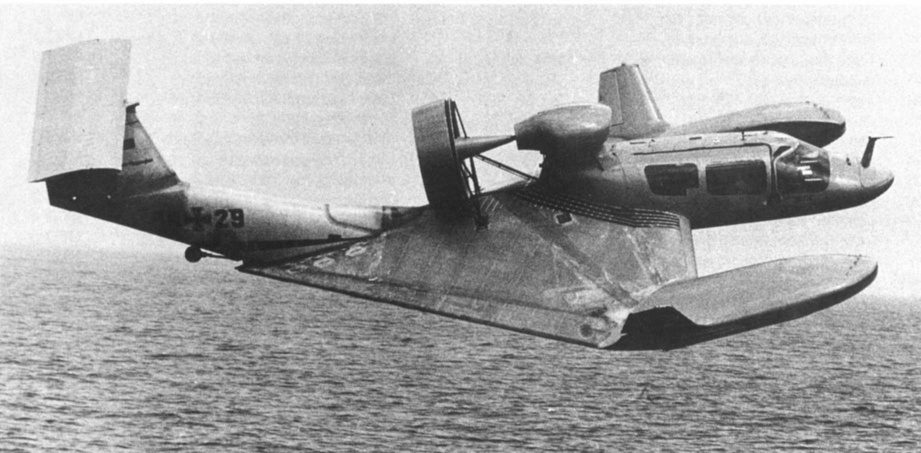
X-114, one of the Lippish prototypes
In the decades since the demise of the Soviet ekranoplan program, there have been numerous attempts to revive the concept. Besides the desperate attempts of Russian design bureaus to attract outside money during the dismal years of the 1990s and 2000s, various efforts have taken place in other countries. Boeing proposed a massive ekranoplan transport under the name Pelican in the early 2000s, which would have been about twice the size of the company's 747 and weighed six times as much, operating from land-based airfields to avoid the drag that comes with operating from the water. More recently, DARPA spent the past few years working on a design dubbed "Liberty Lifter", abandoning it in mid-2025. In Germany, designer Alexander Lippish, best known for the Me 163, decided to turn his talent for extremely sensible aircraft to ekranoplans, developing a radically different reverse-delta configuration in the 1970s. Several small prototypes flew, and it proved to be stable in both pitch and height, which has made it popular with designers of small ekranoplan ever since. And there have been plenty of small companies, far too many to be worth mentioning here, that have attempted to commercialize the concept since then. Despite this, it's not entirely clear if there's even a single one in commercial service right now, although several companies, most notably REGENT are working to change this. I strongly suspect that the problems of rough water will doom them as it has all previous attempts. Frankly, the market here reminds me of that for airships. While the concept is seductive and there's always someone ready with a cool presentation about how this is the future of transportation, the fact that Earth has weather means that conventional versions will soldier on, and the ekranoplan, unlike other exotic hulls, will always remain a curiosity.
1 A Russian word meaning "screen glider". Because of the Russian dominance of the type and the fact that it sounds cool, I plan to use this throughout. ⇑
2 This is called "induced drag", and is separate from parasitic drag, which is produced simply by the motion of the aircraft through the air. For complicated reasons, induced drag is greater at low speeds, with the crossover point being well above Mach 0.5 for a modern airliner. ⇑
3 Yes, I am aware that this is not true for everybody, but if you are being pedantic about it, you know what these planes are. ⇑
4 In fairness, a quite rough stretch of water, selected because I happened to have numbers for it. ⇑
5 More or less. It's very big, and doesn't connect to the world's oceans, and because of that is somewhat saline, though less so than the oceans. In any case, it's big and isolated and fairly calm. ⇑
6 It was bigger in almost every dimension than the "Spruce Goose", except for wingspan. Most of its records were subsequently taken by the An-225. ⇑
7 I'm following the Romanization in my main source, not the one used by Wiki. ⇑
8 Low-flying aircraft put a bit of noise into the water, but nowhere near as much as a moving ship, so in terms of not alerting sonar, this wasn't a terrible idea. ⇑
9 It was also fitted with a magnetic anomaly detector, although sonobuoys were out as a sensor, presumably because their datalinks require line of sight and an ekranoplan flies too low for that to be practical. Unfortunately, the definitive book on Soviet Ekranoplans does not have any information on weapons fit. ⇑

Comments
If this is an intentional joke about turbofan & unducted fan (propfan) & turboprop :: aircraft & ekranoplan & ship, it is appreciated.
Towed glider mobility (both for "everything including infantry", and to supplement parachute infantry with heavier equipment) managed to cut through bureaucracy, because at least for its time, it was a sufficiently better idea than its absence.
By this time the equipment in question (the receiver) wasn't particularly heavy, so surely it would have been possible to take a page from older operations (incl. submarines) and resurrect the "ship"-towed glider/kite/gyro observation (/spotting/etc.) platform? For radar, this would be rather more iffy, but at least power and cooling could be provided through the towing umbilical.
The only question remaining is: can someone figure out how to take a hydrofoil cata-/trimaran sailboat and step it up onto a ground effect wing? (Yes, the question is deliberately silly. Such a craft would still need to transmit the lee force to the water, so unless someone figures out how to do that without contact, they still need to drag a keel through the water even if they gain no lift from it.)
On the other hand, the reason lift-induced drag is greater at slower speeds isn't complicated at all. The downward "exhaust velocity" of the wake is inversely proportional to your forward speed, by conservation of momentum.
Well, that was more insane than I was expecting.
Maybe they would have been (a little) practical in a land war with China over the Gobi Desert.
If you accept that the height of the mean affected air-tube is equal to the wingspan times a coefficient, but I don’t think I ever saw an explanation for why that is the case.
I guess it depends how we think of it. If it's "the largest and heaviest aircraft ever built, but very dangerous to fly and limited to only flying over a very calm lake" then that's terrible. But if you think of it as a boat that can go 300 knots, that's amazing. I wonder if it would be possible to use modern flight control systems to make it safer to fly/steer?
VVS-14 is straight off Ralph McQuarrie's drafting board and nobody can convince me otherwise
@Basil
No, not an intentional joke, just a typo.
I'm not sure on the sonobuoy stuff. The book just said "couldn't use sonobuoys" and I had to make my own guesses as to why.
I'm not sure that's right, and even if it is, I'm not sure that's simple. All else equal, I suppose a faster plane is going to move less air faster, but intuitively I'd expect that to be more drag, not less. But I'm not sure how else to think of the Cl^2 term in the induced drag equation. The point I was getting at was that because of that term, and the fact that non-induced Cd is effectively constant with speed, that starts to get bigger at higher speed.
A boat that can go 300 kts, but can't handle any waves larger than a ripple isn't that impressive either.
On the other hand, if the Soviets wanted to use ekranoplans to actually counter the US Navy they would have to operate in the North Atlantic, wouldn't they?
The Iranian GCN also operates a small amount of WIG craft, the Bavar-2. Debatable how effective they are, but they do operate them.
Is it really coincidence, or intentional to make use of the ground effect on takeoff/landing?
First, an apology. VVA-14 became VVS-14 during the writing of this post, probably due to me literally hitting the wrong key and then referring back to the previous wrong case. This has been fixed.
@quanticle
One of the frustrations of writing this was that there was never a clear "we will use this to go from X to Y" that I wanted. I could see it being useful in, say, the Mediterranean, but didn't run across any specifics for that. And there were definitely some areas where it seemed like they were being incredibly optimistic about rough-water performance.
@Blackshoe
I had actually seen that, but writing this was kind of a mess, and it got lost in the shuffle. I will probably edit it in.
@EngineOfCreation
I'm pretty sure it's a coincidence, because a lot of other stuff (the need for dihedral for stability, length of landing gear, etc) seems a lot more likely to drive that.
Well, it's not like the Soviets figured that out either, which is why no ekranoplans ever advanced beyond the early prototype stage.
I think the most plausible mission for the ekranoplan is actually the anti-submarine mission that was envisioned for the least plausible ekranoplan, the VVA-14. Submarines are quiet, and they can be anywhere, so to counter them it makes sense to have a surface "ship" that can cover a huge amount of distance at high speeds. A hypothetical working ekranoplan would be like a P-3 or P-8 but with even more range and a payload capacity that might as well be infinite.
But, in order to actually counter American submarines any ekranoplan would have to deal with the north Atlantic. And it's not clear that that additional payload capacity actually helps all that much when fighting submarines. I haven't seen very many complaints that the P-3's payload capacity was too low.
Like so much other Soviet mad science, ekranoplans are a solution that doesn't work to a problem that doesn't exist.
Another (probably unanswerable) question I have about ekranoplans is how much of the theoretical efficiency or range advantage actually realizable? I get that wing-in-ground-effect is way more efficient for cruising, but it seems like all the existing ekranoplan designs burn up a lot of that efficiency with their boost engines for taking off. And after takeoff, those boost engines are hanging out, right there in the airflow, causing a lot of parasitic drag without adding any lift or thrust.
EngineOfCreation:
Even the the way the Victor landed wasn't intended.
quanticle:
Even then to use it you have to be at the bottom of the soup, you can't reduce drag by reducing the air density you operate in.
@Quanticle and Anon: my mild tin-foil hat theory about WIGs/E-Plans (based off how many times people have tried to do these things) is that they aren't really useful or economical to build themselves, but in building them, there's a lot of processes and applications that will end up being useful elsewhere. Ekranoplans as concept cars, basically.
Maybe that's true, but I haven't seen very many other vehicles where one can point to a feature and say, "Yes, this was first tested or prototyped on an ekranoplan." The aerodynamics of an ekranoplan aren't really like any other fixed wing aircraft, and developments on ekranoplans don't seem like they can be easily applied to conventional naval vessels.
To me, ekranoplans are one of those things where a smart person can work things out from first principles and think, "Wait a second, this should work!" Then they go ahead and build it (usually with someone else's money) and find out that there are a hundred and one "minor" or "trivial" problems, each of which is individually surmountable, but which, collectively, make the venture infeasible.
SSTO spaceplanes are another example of this.
quanticle:
I thought they were just an example of something that seems cool but which can't actually be done (for added impossibility, make it reusable).
Though just one of them at a time might qualify as an example.
Ekranoplans seem like an attempt to make something with economic performance in between ships and planes but there doesn't really seem to be much of a market there (though they have the advantage over airships of actually being able to be cheaper than a plane).
How many more exotic hulls will this series cover? In light of recent events, I've grown markedly more interested in a treatment of narco-submarines in particular.
How many exotic hulls are there left to cover?
This is the end of the series, at least as far as my plans go. Narco-submarines might be an interesting thing to talk about, but they're not really in the vein I was mining here.
Inflatable hulls? Like Zodiacs.
In my very limited experience they behave fairly differently from normal hulls, and clearly they can offer different capabilities (such as portability).